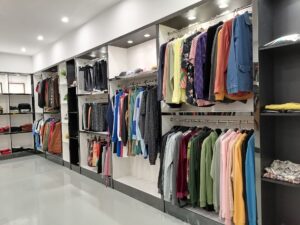what is a common weakness in clothing brand?
As someone deeply involved in the clothing industry, I have seen many brands rise and fall. While the fashion world is exciting and full of potential, it’s also fiercely competitive. One common weakness I’ve observed in clothing brands is the lack of a clear and consistent identity. Let’s explore this and other weaknesses that can hinder a brand’s success.
Lack of a Clear Brand Identity
Problem Analysis:
Many clothing brands in the market lack a clear and well-defined identity, leading to an unclear target audience. This confusion often arises from attempting to cater to too many demographics at once. For example, a brand that simultaneously targets men, women, and children without focusing on a core audience dilutes its appeal. A scattered approach can make it challenging for customers to understand what the brand truly represents.
In some cases, I’ve seen brands lose their market position due to inconsistent messaging and branding strategies. For instance, a mid-range brand adopting luxury visuals might alienate its existing audience without attracting the desired new customers.
Case Study:
One notable example is a mid-sized clothing brand that expanded too quickly into diverse product categories without proper market research. Instead of solidifying its reputation in one niche, the brand’s unfocused offerings confused its audience. Sales declined, and customer loyalty weakened as consumers turned to competitors with clearer brand identities.
Solutions:
- Conduct Market Research:
- Brands need to identify their target audience by understanding their demographics, preferences, and buying behaviors. Surveys, focus groups, and data analysis can provide valuable insights into customer needs.
- Establish a Clear Mission and Values:
- A brand should articulate its mission and core values. For example, whether the brand focuses on sustainability, premium craftsmanship, or affordable fashion, this clarity helps customers form a connection.
- Develop Consistent Messaging:
- All communication, from advertising campaigns to social media posts, should align with the brand’s identity. Consistency builds trust and reinforces the brand’s position in the market.
SWOT Analysis of Clothing Brands
A SWOT analysis is a powerful tool to evaluate a brand’s Strengths, Weaknesses, Opportunities, and Threats. Here is how it applies to clothing brands:
Strengths:
- Unique Brand Identity: Brands with a clear vision and consistent messaging tend to build stronger customer loyalty.
- High-Quality Products: Superior materials and craftsmanship can set a brand apart from competitors.
- Strong Distribution Network: Efficient supply chains ensure timely product delivery and lower operational costs.
Weaknesses:
- Inconsistent Quality Control: As mentioned earlier, poor quality can harm a brand’s reputation.
- Limited Digital Presence: In today’s market, a lack of online visibility is a major disadvantage.
- Resistance to Innovation: Failure to adapt to industry trends and technologies can make a brand irrelevant.
Opportunities:
- Sustainability and Ethics: Consumers increasingly prefer brands that prioritize eco-friendly practices and fair labor conditions.
- Expansion to Niche Markets: Exploring underserved niches, such as adaptive clothing or inclusive sizing, can open new revenue streams.
- Leveraging Technology: Adopting AI for inventory management or AR for virtual try-ons can enhance the customer experience.
Threats:
- Intense Competition: The saturated market makes it difficult for brands to stand out.
- Economic Downturns: Fluctuations in disposable income can directly affect sales.
- Changing Consumer Preferences: Rapid shifts in fashion trends and demands require constant adaptation.
Poor Quality Control
Quality is the cornerstone of any successful clothing brand. However, I’ve seen brands compromise on materials, stitching, or fit to cut costs. This might save money in the short term but damages the brand’s reputation over time. Customers are quick to notice when a garment feels cheap or falls apart after a few washes. If the quality isn’t consistent, customers are unlikely to return.
Inefficient Supply Chain Management
A poorly managed supply chain can lead to delays, stock shortages, or excess inventory. I’ve worked with clients who faced significant losses because they couldn’t get their products to market on time. In today’s fast-paced industry, customers expect quick delivery, and failing to meet those expectations can push them towards competitors. Moreover, inefficiencies in production often increase costs, squeezing profit margins.
Overdependence on Trends
Fashion trends are fleeting, and chasing them can be risky. I’ve seen brands that rely heavily on producing trend-driven items struggle to maintain customer loyalty. While trendy pieces can attract attention, they don’t build lasting relationships with customers. A successful brand balances trend-inspired designs with timeless staples that resonate with its target audience.
Insufficient Marketing Strategies
Marketing plays a critical role in a clothing brand’s success. However, I’ve noticed that many brands either overspend on ineffective campaigns or don’t invest enough in marketing at all. For instance, a poorly planned social media strategy can result in low engagement or even negative feedback. It’s crucial to understand the target audience and craft campaigns that genuinely connect with them.
Neglecting Sustainability and Ethical Practices
Sustainability is no longer optional in today’s market. I’ve observed that brands ignoring ethical practices often face backlash from customers and the media. Fast fashion, in particular, has come under scrutiny for its environmental and social impact. Brands that fail to adopt sustainable practices risk alienating a growing segment of eco-conscious consumers.
Weak Customer Engagement
Customer loyalty is built through engagement, and I’ve seen brands struggle to maintain meaningful relationships with their audience. Whether it’s neglecting customer feedback, offering poor after-sales support, or failing to create a sense of community, weak engagement can lead to declining sales. Strong communication, loyalty programs, and personalized experiences can significantly strengthen customer ties.
Inadequate Product Differentiation
The market is saturated with clothing brands, and standing out is a challenge. I’ve encountered brands that fail to offer unique designs, innovative features, or a compelling value proposition. Without differentiation, customers have little reason to choose one brand over another. Focusing on what makes a brand unique—be it design, functionality, or brand story—is critical to success.
Mismanagement of Pricing Strategies
Pricing can make or break a brand. I’ve seen companies either overprice their products, alienating potential buyers, or underprice them, diminishing perceived value. Striking the right balance between affordability and exclusivity is essential. Understanding the target market’s willingness to pay and offering value for money can enhance brand perception.
Resistance to Change
The fashion industry evolves rapidly, and staying stagnant can be detrimental. I’ve noticed some brands resist adopting new technologies, such as e-commerce platforms or AI-driven analytics, which limits their growth potential. Embracing innovation, whether in design, production, or marketing, is essential for staying competitive.
Overcoming These Weaknesses
Recognizing these common weaknesses is the first step towards building a stronger clothing brand. By focusing on a clear brand identity, ensuring quality, streamlining the supply chain, and staying customer-focused, brands can position themselves for long-term success. The key is to be adaptable, innovative, and consistent in delivering value to customers.
I believe that every challenge presents an opportunity. Addressing these weaknesses head-on not only strengthens the brand but also sets the foundation for sustainable growth in a competitive industry.







